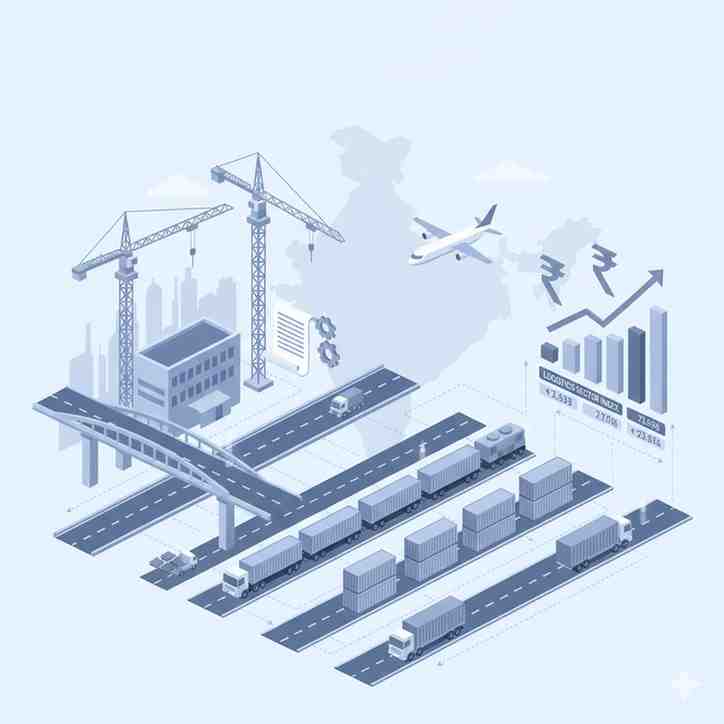
Government Policies and Infrastructure Push: What It Means for Logistics Stocks
Government Policies and Infrastructure Push: What It Means for Logistics Stocks
India’s logistics sector has become a key pillar in supporting the country’s economic expansion. With the government’s focus on improving infrastructure and implementing investor-friendly policies, logistics has emerged as a high-potential industry for both growth and investment. As supply chains become more integrated and technology-driven, logistics stocks in India are witnessing renewed investor attention.
Thank you for reading this post, don't forget to subscribe!This article explores the impact of government policies on logistics stocks in India, the role of infrastructure development, and how these changes are shaping investment opportunities in the sector.
Impact of Government Policies on Logistics Stocks in India
Government policies have a significant influence on how the logistics sector evolves. Over the past few years, several initiatives have been introduced to streamline operations, enhance connectivity, and reduce logistics costs — a major factor in improving trade competitiveness.
Key policies such as the National Logistics Policy (NLP) and the PM Gati Shakti National Master Plan have been designed to create an integrated infrastructure network that connects roads, railways, ports, and air transport. These policies aim to reduce logistics costs to 8–9% of GDP from the current 13–14%, aligning India with global standards.
For investors, these initiatives signal long-term growth potential. Companies operating in freight management, warehousing, cold chain, and transport services are likely to benefit as the government continues to improve the logistics ecosystem. Consequently, logistics stocks listed in Indian markets have gained attention for their potential to deliver consistent returns over time.
How Infrastructure Development Is Driving Logistics Sector Growth
India’s logistics sector is directly linked to infrastructure development. Projects under the Bharatmala and Sagarmala programs, along with the expansion of Dedicated Freight Corridors (DFCs), are transforming the way goods move across the country.
The infrastructure development driving logistics sector growth is evident in multiple ways:
- Improved connectivity: Multi-modal transport systems enable faster and more efficient cargo movement.
- Reduction in transit times: Upgraded highways, ports, and railway corridors cut travel time and operational expenses.
- Growth in warehousing: The demand for Grade-A warehouses is expanding due to the rise in e-commerce and organized retail.
For listed companies, such as container terminal operators, logistics parks, and transportation service providers, these developments enhance operational efficiency — a crucial factor for improving margins and sustaining profitability.
Government Initiatives Supporting Logistics Companies in India
The logistics industry’s transformation is being driven by government initiatives supporting logistics companies in India, many of which focus on digitalization, transparency, and standardization.
Some key initiatives include:
- National Logistics Portal (NLP-Marine): A unified digital platform simplifying trade documentation and port operations.
- PLI (Production Linked Incentive) Schemes: Encouraging manufacturing growth, which in turn drives logistics demand.
- Ease of Doing Business Reforms: Simplified regulatory procedures reduce compliance burdens for logistics players.
- Green logistics policies: The government’s focus on sustainability has prompted investment in cleaner and more energy-efficient logistics solutions.
As a result, logistics firms that align with these initiatives — by adopting digital solutions, expanding infrastructure, or focusing on eco-friendly operations — are better positioned to attract institutional and retail investors.
Investment Opportunities in the Indian Logistics Sector
With rising demand for efficient supply chain solutions, there are growing investment opportunities in the Indian logistics sector. Investors are looking beyond traditional transportation companies to businesses that provide integrated logistics services — including warehousing, inventory management, and cold-chain logistics.
Several logistics companies are now listed on Indian stock exchanges, reflecting the sector’s maturity and investor interest. The increased adoption of technology, automation, and data analytics has further enhanced the sector’s investment appeal.
Investors may also consider thematic exposure through logistics-focused mutual funds or ETFs, which allow diversified participation in the sector’s growth story. These instruments can be particularly attractive for those seeking exposure to the broader infrastructure and manufacturing revival in India.
How India’s Infrastructure Push Influences Logistics Stocks Performance
The infrastructure push influencing logistics stocks performance can be seen in rising earnings expectations and expanding capacity utilization among logistics companies. As infrastructure bottlenecks ease, businesses are able to operate more efficiently, reducing delays and costs.
Additionally, the Make in India and Atmanirbhar Bharat initiatives are boosting domestic production, leading to increased movement of goods across the country. This trend directly benefits logistics firms that manage transportation, warehousing, and distribution networks.
Over time, as these infrastructure investments translate into higher trade volumes, logistics companies are expected to experience improved profitability and stronger balance sheets — enhancing their attractiveness to investors seeking steady, long-term returns.
The Broader Economic Impact
The logistics sector not only supports trade but also plays a vital role in employment generation and regional development. Enhanced connectivity leads to greater access to markets, benefiting small and medium enterprises (SMEs) and contributing to the overall economic ecosystem.
From a market perspective, logistics is becoming an integral part of India’s infrastructure growth narrative. Investors focusing on logistics stocks in India should consider both macroeconomic trends and company-specific fundamentals before making investment decisions.
Conclusion
The combination of government policies and infrastructure development has set the stage for India’s logistics sector to grow into a globally competitive industry. With consistent policy support and a national focus on connectivity, the sector is positioned for long-term expansion.
For investors, understanding the impact of government policies on logistics stocks in India and recognizing how infrastructure initiatives drive performance can help in identifying sustainable investment opportunities.
As India strengthens its logistics framework, companies that adapt to new technologies, expand their networks, and align with government initiatives are likely to emerge as key beneficiaries — offering steady value creation for investors seeking exposure to one of India’s most promising growth stories.
Related Blogs:
Long-Term Investment Potential of Logistics Sector Stocks in India
How Drone Applications in Agriculture and Logistics Impact Indian Companies
Growth Potential of Drone Technology in India’s Stock Market
How India’s Defence Investments Are Fueling Demand for Drone and Semiconductor Stocks
From Satellites to Launchpads: Exploring Sub-Sectors in Indian Space Stocks
Diversifying Your Portfolio with Defense Stocks: A Strategic Move?
India’s Defense Transformation and Its Impact on Defense Stocks
Technological Innovations Driving Defense Sector Growth: AI, Drones, Cyber Security
Data Localization: Impact on Cybersecurity and Data Center Companies Growth in India
Can Defense Stocks Shield Your Investment Portfolio?
Best Defense Stocks in India
Top Stock Picks for 2025 Best Investment Opportunities
Top 5 Cybersecurity Stocks in India
Best Drone Stocks in India
Best Data Center Stocks in India
Best Information Technology Stocks in India
Top 5 Drone Stocks in India
Disclaimer: This blog post is intended for informational purposes only and should not be considered financial advice. The financial data presented is subject to change over time, and the securities mentioned are examples only and do not constitute investment recommendations. Always conduct thorough research and consult with a qualified financial advisor before making any investment decisions.

